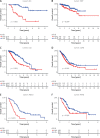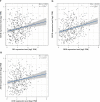Identification of ASF1B as a prognostic marker for liver cancer by meta-analysis and its immune value revealed by a comprehensive pan-cancer analysis of 33 human cancers
- PMID: 37937108
- PMCID: PMC10626391
- DOI: 10.5114/pg.2023.124423
Identification of ASF1B as a prognostic marker for liver cancer by meta-analysis and its immune value revealed by a comprehensive pan-cancer analysis of 33 human cancers
Abstract
Introduction: As one of the most common malignant tumours, liver cancer is difficult to detect in the early stage, with strong metastasis and poor prognosis. Anti-silencing function protein 1 was originally discovered in yeast as a histone H3-H4 chaperone, and studies have shown that ASF1B may be a target for inhibiting the growth of hepatocellular carcinoma cells.
Aim: To evaluate the diagnostic and prognostic significance of ASF1B expression in human LIHC on the basis of TCGA data.
Material and methods: A meta-analysis revealed that high ASF1B expression was strongly associated with better overall survival. A comprehensive pan-cancer analysis of 33 human cancers revealed the immunotherapeutic value of ASF1B.
Results: In this study, we observed a significant upregulation of ASF1B expression in LIHC samples compared to non-cancer samples. Clinical analysis showed that high expression of ASF1B was associated with age, tumour status, and clinical stage. Survival analysis showed that patients with high ASF1B expression had worse overall survival and progression-free survival than patients with low ASF1B expression. The AUCs of the 1-year, 3-year, and 5-year survival-related ROC curves were 0.672, 0.590, and 0.591, respectively.
Conclusions: Our study shows that ASF1B may provide new ideas for the diagnosis and prognosis of liver cancer patients, as well as providing a new direction for the application of ASF1B in tumour immunotherapy.
Keywords: ASF1B; anti-silencing functional protein 1; immunity; liver cancer; pan cancer.
Copyright © 2023 Termedia.
Conflict of interest statement
The authors declare no conflict of interest.
Figures













Similar articles
-
Comprehensive Pan-Cancer Analysis and the Regulatory Mechanism of ASF1B, a Gene Associated With Thyroid Cancer Prognosis in the Tumor Micro-Environment.Front Oncol. 2021 Aug 20;11:711756. doi: 10.3389/fonc.2021.711756. eCollection 2021. Front Oncol. 2021. PMID: 34490109 Free PMC article.
-
ASF1B is a Promising Prognostic Biomarker and Correlates With Immunotherapy Efficacy in Hepatocellular Carcinoma.Front Genet. 2022 Mar 10;13:842351. doi: 10.3389/fgene.2022.842351. eCollection 2022. Front Genet. 2022. PMID: 35360875 Free PMC article.
-
Comprehensive analysis of pan-cancer reveals potential of ASF1B as a prognostic and immunological biomarker.Cancer Med. 2021 Oct;10(19):6897-6916. doi: 10.1002/cam4.4203. Epub 2021 Sep 2. Cancer Med. 2021. PMID: 34472711 Free PMC article.
-
Carcinogenic Role and Clinical Significance of Histone H3-H4 Chaperone Anti-silencing Function 1 B (ASF1B) in Lung Adenocarcinoma.J Cancer. 2024 Jan 1;15(1):218-231. doi: 10.7150/jca.88777. eCollection 2024. J Cancer. 2024. PMID: 38164276 Free PMC article.
-
ASF1B Serves as a Potential Therapeutic Target by Influencing Cell Cycle and Proliferation in Hepatocellular Carcinoma.Front Oncol. 2022 Jan 11;11:801506. doi: 10.3389/fonc.2021.801506. eCollection 2021. Front Oncol. 2022. PMID: 35087760 Free PMC article.
Cited by
-
The oncogenic role and prognostic value of PXDN in human stomach adenocarcinoma.BMC Cancer. 2024 Nov 28;24(1):1463. doi: 10.1186/s12885-024-13097-6. BMC Cancer. 2024. PMID: 39609679 Free PMC article.
References
Publication types
LinkOut - more resources
Full Text Sources
Research Materials
Miscellaneous
